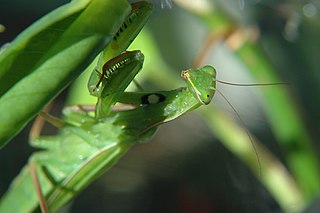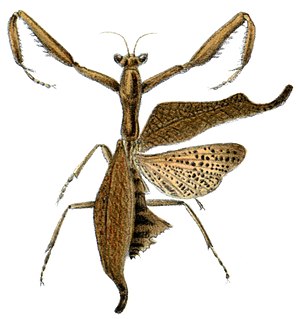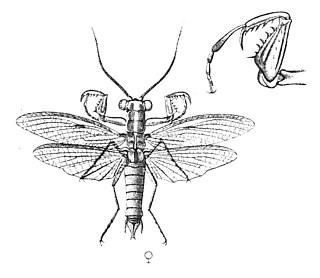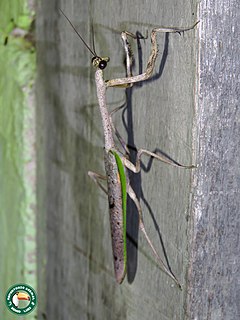
Mantidae is one of the largest families in the order of praying mantises, based on the type species Mantis religiosa; however, most genera are tropical or subtropical. Historically, this was the only family in the order, and many references still use the term "mantid" to refer to any mantis. Technically, however, "mantid" refers only to members of the family Mantidae, and not the 14 remaining families of mantises. Some of the most recent classifications have promoted a number of the mantid subfamilies to the rank of family, e.g. Iridopterygidae, Sibyllidae, Tarachodidae, Thespidae, and Toxoderidae, while other classifications have reduced the number of subfamilies without elevating to higher rank.

The mantis family Metallyticidae consists of a single small genus, Metallyticus, living mostly in South-East Asia. The species are dark, somewhat flattened and cockroach-like, often with a cuticle that is reflective and metallic in appearance.

The genus Mantis is in the family Mantidae, of the mantis order Mantodea.

Choeradodis is a genus of praying mantises with common names such as shield mantis, hood mantis, and leaf mantis because of their extended, leaf-like thoraces. The distinguishing characteristic of Choreododis from which it takes its common names is a laterally expanded thorax. This adaptation for the purpose of camouflage, as well as a rounded wing case and a habit of staying relatively flattened, aid its leaf mimicry.

Acanthops falcataria, common name South American dead leaf mantis, is a species of praying mantis in the family Acanthopidae. It is not to be confused with Acanthops falcata, a different species in the same genus that is often referred to with the same common name.

Zoolea is a South American genus of praying mantises.

Rhombodera is a genus of praying mantises native to Asia and possessing common names such as shield mantis, hood mantis, and leaf mantis because of their extended, leaf-like thoraxes.
Hierodula fruhstorferi is a praying mantis species in the subfamily Hierodulinae.
Toxoderidae is a family of praying mantises.

Mantises are an order (Mantodea) of insects that contains over 2,400 species in about 430 genera in 30 families. The largest family is the Mantidae ("mantids"). Mantises are distributed worldwide in temperate and tropical habitats. They have triangular heads with bulging eyes supported on flexible necks. Their elongated bodies may or may not have wings, but all Mantodea have forelegs that are greatly enlarged and adapted for catching and gripping prey; their upright posture, while remaining stationary with forearms folded, has led to the common name praying mantis.

Mantoididae is a family of order Mantodea which contains Neotropical species of praying mantises from tropical North and South America. The family was formerly represented by the sole genus Mantoida, however the genus Paramantoida was described in 2014 and Vespamantoida in 2019. The family differs from the closely related Chaeteessidae in having an apical claw on the fore tibiae which are also less curved. Males have ocelli and a cylindrical body shape, unlike the dorsoventrally flattened Chaeteessidae. The cerci are also shorter.

Stenophylla is a genus of praying mantis in the subfamily Stenophyllinae, which is now placed in the family Acanthopidae. It the sole genus of the tribe Stenophyllini.
Phasmomantella is an genus of praying mantids placed in the tribe Euchomenellini and family Deroplatyidae. The two known species appear to be endemic to Vietnam.
Vespamantoida is a genus represented by two species of praying mantises in the family Mantoididae. The genus was erected in 2019 and the name was derived from the Latin word vespa which means wasp and Mantoida referring to the mantis. These mantis resemble and mimic the behavior of a wasp.
Vespamantoida wherleyi is a species of praying mantis that mimics a wasp. It was discovered in 2013 at a research station near the Amazon River in Northern Peru. The discovery resulted in erecting a new genus, Vespamantoida. This mantis has a red/orange colored body and black pattern. Besides the coloration, it has the body shape of and displayed walking and antenna movements similar to a wasp. This mantis is in close relation to the Mantoida toulgoeti Roy species. Both species have distinct foreleg synapomorphy.

Pseudovates is a genus of praying mantis in the family Mantidae. There are more than 20 described species in Pseudovates, found in North, Central, and South America.

The Hierodulinae are a subfamily of praying mantids, originally used by Brunner von Wattenwyl. It was restored as part of a major revision of mantid taxonomy, and now contains genera previously placed elsewhere in the family Mantidae.

Liturgusa is the type genus of praying mantids of the family Liturgusidae. The genus consists of more than twenty species with a Neotropical distribution.
Titanodula is a genus of mantids in the subfamily Hierodulinae. There are currently four species placed in Titanodula. The genus is endemic to Asia and is distinguished from the similar genus Hierodula by the large size and unique male genitalia of its member species.













